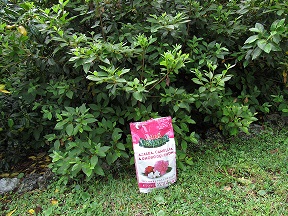Fertilize spring-blooming shrubs such as azaleas and camellias right after they finish flowering. The plants have just used a lot of resources to produce flowers, and both azaleas and camellias push new flushes of leaves immediately after they bloom, as well. By the time they’re finished with all of that growth and activity they can use a bit of replenishing. Do them a favor by fertilizing with Jobe’s Organics Azalea, Camellia, and Rhododendron fertilizer.
Feed the Soil Not the Plants
Wait, did I not just tell you to feed your plants? Actually, you’re going to feed the soil around the plants. Plants get most of the nutrients that they need in order to grow, including the “big three” Nitrogen, Phosphorous, and Potassium, from the soil. The pH of the soil affects whether the nutrients are available to plants (among other things). Azaleas, Camellias, Rhododendrons, Hollies, Blueberries, and gardenias all thrive in soil that has an acidic, or lower pH. Some fertilizers will elevate the pH to the point where it is difficult for plants to take up the nutrients they need. That’s why it’s important to fertilize with plant food that will maintain ideal pH levels for the plants you’re feeding. Jobe’s Organics Azalea, Camellia, and Rhododendron Fertilizer contains a mixture of nutrients, minerals, beneficial bacteria, and beneficial fungi, all specially formulated for acid-loving plants.
How to Fertilize Azaleas and Camellias
Always follow directions on the fertilizer bag or label. Those directions reflect the current knowledge about safely and appropriately applying fertilizer to your garden.
When to fertilize
Plan to fertilize Azaleas and Camellias when there is no immediate rain in the forecast. While you will “water in” the fertilizer, you don’t want it to get washed away in a sudden downpour, because that will 1) waste your money and 2) pollute the waterways. (Even too much organic fertilizer can cause algal blooms downstream.)
How much fertilizer to use
New trees and shrubs: Mix one cup of Jobe’s Organics fertilizer with the soil in the planting hole before planting.
Established shrubs: Fertilize with 1 cup of fertilizer per foot of branch spread. For example, a 4 foot wide shrub will need 4 cups of fertilizer.
Established trees: Measure the trunk diameter at one foot off the ground. Fertilize with three cups per inch of trunk diameter. (This applies to camellias—and holly trees, for that matter.)
Where to apply the fertilizer
The best place to apply the fertilizer is between four inches out from the trunk to the edge of the dripline. (The dripline is where the branches end.) If there is mulch around the tree or shrub, remove it before fertilizing.
How to apply the fertilizer
Sprinkle the fertilizer in the correct area and then use a soil knife, rake, or hand trowel to lightly rake it into the soil. Thoroughly water the area that you have fertilized.
Soil organisms and beneficial bacteria and fungi in Jobe’s Organic fertilizers will break down the fertilizer into the small components that the plants can take up through the roots. By watering, you will jump-start this process.
Katie Elzer-Peters
gardens in the coastal town of Wilmington, North Carolina. She grows vegetables and has extensive mixed border gardens throughout her half acre property. She has a Bachelor of Science in Public Horticulture from Purdue University and a Master of Science in Public Horticulture from the University of Delaware and the Longwood Graduate Program. Katie has written eight books about gardening for Cool Springs Press.

